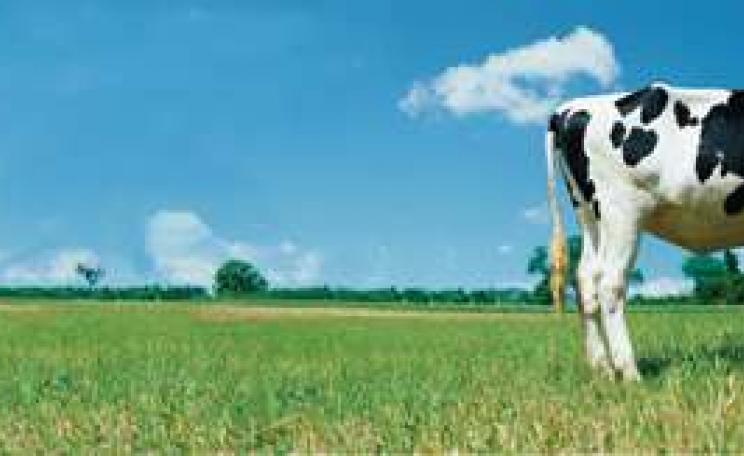The truth: small farms produce more agricultural output per unit area than large ones. Moreover, larger, less diverse farms require far more mechanical and chemical inputs, which are ruinous for the environment.
Proponents of industrial agriculture claim that 'bigger is better' when it comes to food production. They argue that the larger the farm, the more efficient it is. They admit that these huge corporate farms mean the loss of family farms and rural communities, but they maintain that this is simply the inevitable cost of efficient food production. And agri-business advocates don't just promote big farms; they also push big technology. They typically ridicule small-scale farm technology as grossly inefficient, while heralding intensive use of chemicals, massive machinery, computerisation and genetic engineering - the affordability and implementation of which are only feasible on large farms. The marriage of huge farms with 'mega-technology' is sold to the public as the basic requirement for efficient food production. Argue against size and technology - the two staples of modern agriculture - and, agri-business apologists insist, you're undermining production efficiency and endangering the world's food supply.
Small is bountiful
While the bigger-is-better myth is generally accepted, it is a fallacy. Numerous reports have found that smaller farms are actually more efficient than larger industrial farms. These studies demonstrate that when farms get larger the costs of production per unit often increase, because larger acreage requires more expensive machinery and more chemicals to protect crops. In particular, a 1989 study by the US National Research Council (NRC) assessed the efficiency of large industrial food production systems compared with alternative methods. The NRC's conclusion was exactly contrary to the bigger-is-better myth. 'Well-managed alternative farming systems nearly always use less synthetic chemical pesticides, fertilisers and antibiotics per unit of production than conventional farms,' the NRC found. 'Reduced use of these inputs lowers production costs and lessens agriculture's potential for adverse environmental and health effects, without decreasing - and in some cases increasing - per-acre crop yields and the productivity of livestock management systems.'
Moreover, the large monocultures used in industrial farming undermine the genetic integrity of crops, making them more susceptible to diseases and pests. A majority of our food biodiversity has already been lost. This genetic weakening of our crops makes future food productivity using the industrial model far less predictable and undermines any future efficiency claims of modern agriculture. Moreover, as these crops become ever more susceptible to pests, they require ever greater use of pesticides to produce equal amounts of food - a classic case of the law of diminishing returns. This increasing use of chemicals and fertilisers in our food production results in serious health and environmental impacts.
So, how does the bigger-is-better myth survive? Partly because of a deeply flawed method of measuring farm productivity that falsely boosts the efficiency claims of industrial agriculture while discounting the advantages of small-scale farming.
OUTPUT VERSUS YIELD
Agri-business and economists alike tend to use 'yield' measurements when calculating the productivity of farms. Yield can be defined as the production per unit of a single crop. For example, a corn farm will be judged by how many metric tons of corn are produced per acre. More often than not, the highest yield of a single crop like corn can be best achieved by planting it alone on an industrial scale in the fields of corporate farms. These large mono-cultures have become endemic to modern agriculture for the simple reason that they are the easiest to manage with heavy machinery and intensive chemical use. It is the single-crop yields of these farms that are used as the basis for the bigger-is-better myth, and it is true that the highest yield of a single crop is often achieved through industrial monocultures.
Smaller farms can rarely compete with this monoculture single-crop yield. They tend to plant crop mixtures, a method known as 'inter-cropping'. Additionally, where single-crop monocultures have empty 'weed' spaces, small farms use these spaces for crop planting. They are also more likely to rotate or combine crops and livestock, with the resulting manure replenishing soil fertility. These small-scale integrated farms produce far more per unit area than large farms. Though the yield per unit area of one crop - corn, for example - may be lower, the total output per unit area for small farms (often producing more than a dozen crops and numerous animal products) is nearly always higher than that of larger farms.
Clearly, if we are to compare accurately the productivity of small and large farms, we should use total agricultural output balanced against total farm inputs and 'externalities', rather than single-crop yield as our measurement principle. Total output is defined as the sum of everything a small farmer produces - various grains, fruits, vegetables, fodder and animal products - and is the real benchmark of efficiency. Moreover, productivity measurements should also take into account total input costs - including large-machinery and chemical use, which often are left out of the equation in the yield-efficiency claims. Perhaps most important, however, is the inclusion of the cost of externalities such as environmental and human health impacts, which industrial scale monoculture farms allow society to pay. Continuing to measure farm efficiency through single-crop yield in agricultural economics represents an unacceptable bias against diversification, and reflects the bizarre conviction that producing one food crop on a large scale is more important than producing many crops (and higher productivity) on a small scale.
Once the flawed yield measurement system is discarded, the bigger-is-better myth is shattered. As food policy expert Peter Rosset says: 'Surveying the data, we indeed find that small farms almost always produce far more agricultural output per unit area than larger farms. This is now widely recognised by agricultural economists across the political spectrum as the "inverse relationship between farm size and output".' Rosset notes that even the World Bank now advocates redistributing land to small farmers in the Third World as a step toward increasing overall agricultural productivity.
Government studies underscore this 'inverse relationship'. According to a 1992 US Agricultural Census report, relatively smaller farm sizes are two to 10 times more productive per unit acre than larger ones. The smallest farms surveyed in the study, those of 27 acres or less, are more than 10 times as productive (in dollar output per acre) than large farms (6,000 acres or more), and extremely small farms (four acres or less) can be over 100 times as productive.
In a last-gasp effort to save the efficiency myth, agri-businesses will claim that larger farms are at least able to make more efficient use of farm labour and modern technology than smaller farms. Even this claim cannot be maintained. There is virtual consensus that, because of management and labour problems inherent in large operations, larger farms do not make as good use of even these production factors. Mid-sized and many smaller farms come far closer to peak efficiency when these factors are calculated.
It is generally agreed that an efficient farming system would be immensely beneficial for society and our environment. It would use the fewest resources for the maximum sustainable food productivity. Heavily influenced by the bigger-is-better myth, we have converted to industrial agriculture in the hope of creating a more efficient system. We have allowed trans-national corporations to run a food system that eliminates livelihoods, destroys communities, poisons the earth, undermines biodiversity and doesn't even feed the people. All in the name of efficiency. It is indisputable that this highly touted modern system of food production is actually less efficient, less productive than small-scale alternative farming. It is time to re-embrace the virtues of small farming, with its intimate knowledge of how to breed for local soils and climates, its use of generations of knowledge and techniques like inter-cropping, cover-cropping and seasonal rotations, its saving of seeds to preserve genetic diversity, and its better integration of farms with forest, woody shrubs, and wild plant and animal species. In other words, it's time to get efficient.
Reprinted with permission from Fatal Harvest: The Tragedy of Industrial Agriculture, edited by Andrew Kimbrell, distributed by Island Press, www.islandpress.org





